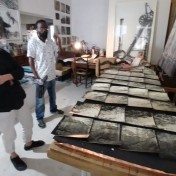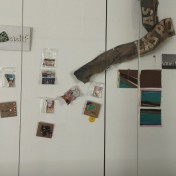This is a preview (a pre-announcement) of the exhibition that we were going to open this week (November 8, 2024): “Geomatics: Land | Law | Minerals”, by a multidisciplinary group of artists and other professionals dedicated to the territory, South Africans, a group directed by Jeannette Unite; an exhibition whose opening we have postponed given the situation we are experiencing with flooding and its consequences, especially in the southern part of the city of Valencia (beyond the new Turia riverbed) and in many other municipalities of l’Horta Sud district.
Resolution of the call “Irrigation in the city”
Publications
Resolution of the call "Irrigation in the city"
“Eastern Mind: The Lost Souls of Tong Nou” (1994), Osamu Sato
Screening
Above on the screen of this Screening you can see, from Osamu Sato, one of the video game artists present at the exhibition “Devil Sun: Surviving Japanese Survival Horror”, his work “Eastern Mind: Lost Souls of Tong Nou”. Well, actually what you can see is a Full Playthrough, a video that shows how someone played the entire game. The real game can be enjoyed at La Posta Foundation.
Osamu Sato, Kenji Eno & Kikiyama
Texts
In the video game exhibition “Devil Sun: Surviving Japanese Survival Horror”, curated by Aitor de Maenza and Sergio Martín, works by three great Japanese artists are on display: Osamu Sato, Kenji Eno and Kikiyama. We cannot say much about Kikiyama, as he jealously hides his identity. But, as far as Osamu Sato and Kenji Eno are concerned, it should be noted that they are not only graphic designers and video game developers, but also musicians.
Call for the development of artistic projects: “Urban Irrigation”
Publications
La Posta Foundation – Image Research Laboratory, has always paid special attention to artistic projects that focused on the territory and the landscape. Sometimes the most immediate territory (the Carmen neighborhood itself) and other times with a broader perspective. Sometimes with a more anthropological content and other times focusing attention on the landscapes.
Plastic contexts
Publications
As I walked through L’Horta I collected small material remains: natural or discarded objects. He always accompanied the selection of...
Read more »
Faitanar/Sociòpolis/La Torre and El Perellonet
Publications
Faitanar/Sociòpolis/La Torre and El Perellonet
territory/subject/use/object
Publications
The evolution of the view on landscape as an object of study, analysis and reference in art over the years has served numerous artists in the development of its conceptualization. The purposes of that view, previously stagnant, are currently varied and interdisciplinary. The very conception of the landscape has changed over the centuries until reaching the present day where it is man and not nature that predominates over its construction. We are in the era of what the Nobel Prize in Chemistry Paul Crutzen called “Anthropocene”, a point of no return in which man is the transformer of the environment with a global and geological reach.
Entropic landscapes. The exhibition
Texts
The exhibition “Entropic Landscapes” is the end of the Workshop on Entropic Landscape, forming part of the [simulated] public participation process that has been proposed as part of the program of said Workshop, because, is in this way like all the rules and protocols of action in relation to with the declaration of Cultural Landscapes and Historical Sites demand it. From this perspective of the public participation process, what the exhibition seeks, like the rest of the activities planned in the public participation plan prepared by the participants in the Workshop, is to transmit to the public the experience of the identification and characterization of entropic landscapes, that we have been discovering in the different routes developed during the Workshop.
El Perellonet
Routes
The settlements known as El Perellonet has its origins in the gola of the same name, built in 1903. Next to it, the house was built for the person in charge and guard of the floodgates, where the Blayet family settled, to the present, which He runs a very famous restaurant in the town. The construction of the Nazareth-Oliva road in 1920 also contributed significantly to the formation of the settlements. In the 1930s, the first elver fishermen began to settle in very precarious huts, seeking proximity to the elver nurseries. These barracks would later be replaced on the mainland by the popular fishermen's houses characterized by their roof in the shape of an inverted catenary, which can be seen in what is known as the Marques de Valterra Housing Group, in honor of the man who was its promoter.










